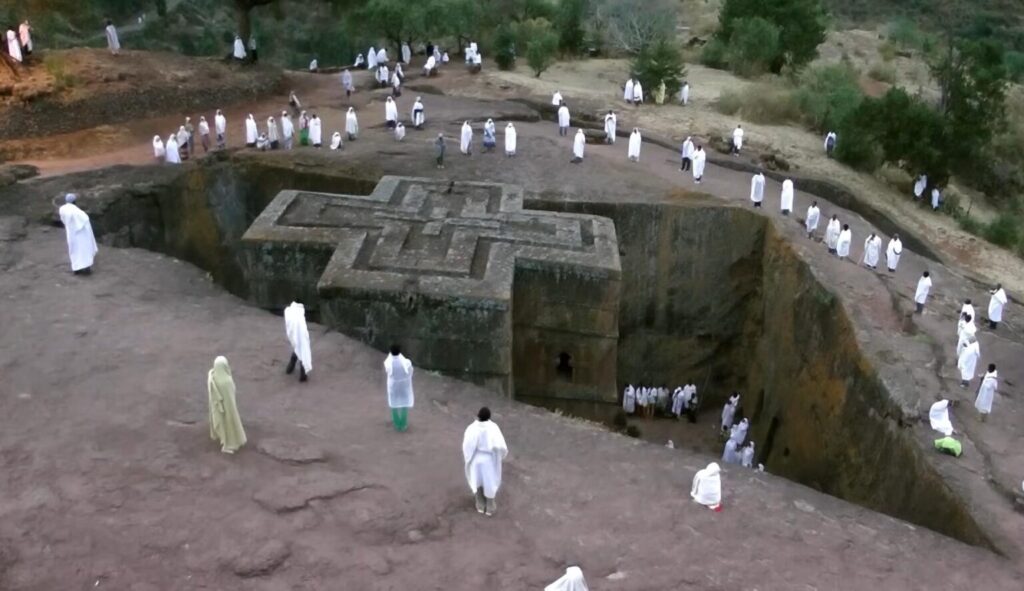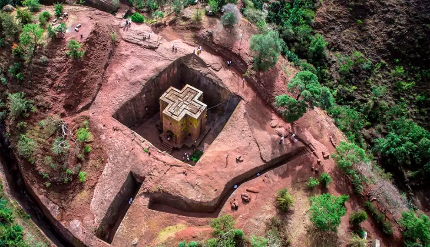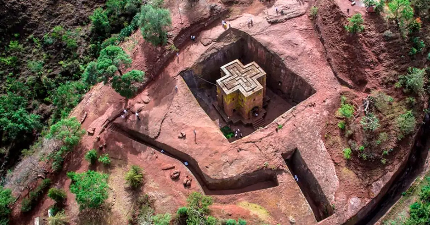Amid Ethiopia’s expansive landscapes lies Lalibela, a mystical town that transcends mere geography. It serves as a portal to ancient times, where its awe-inspiring rock-cut churches have captivated historians, archaeologists, and explorers alike.
These singular architectural marvels stand as a testament to the creative genius and deep religious fervor of a venerable culture. More than mere buildings, the churches of Lalibela are narratives etched in stone, beckoning us to unravel the mysteries they encapsulate.

Located approximately 370 miles north of Addis Ababa and perched at an altitude of 8,200 feet, Lalibela boasts eleven monumental churches meticulously hewn from the bedrock of the earth. These structures, unrivaled in scale among monolithic constructions globally, have stood as silent guardians of the landscape for over 800 years. Recognized as a UNESCO World Heritage site, their origins are shrouded in mystery and held in deep reverence.
Named after King Lalibela of the Zagwe dynasty, the town was envisioned as a New Jerusalem for pilgrims unable to journey to the Holy Land. This ambitious undertaking resulted in a sanctuary that mirrored the biblical Jerusalem, complete with its own interpretation of the River Jordan. The genesis of these sacred sites, however, may stretch back further in history, with churches like Merkorios, Gabriel-Rufael, and Danagel potentially predating King Lalibela’s era, serving as defensive bastions or royal structures during the decline of the Axumite Kingdom. These are the Monolithic Marvels of Lalibela.

The eleven churches of Lalibela are ingeniously split into two main groups, with Bet Giorgis standing out for its singular grandeur. Carved directly from the rock, these structures are interconnected by a labyrinthine network of passages and tunnels, each showcasing unique architectural features. Elaborate carvings adorn the exteriors, while the interiors are adorned with frescoes and sacred artifacts that narrate stories of faith and devotion. Among them, the imposing Medhane Alem impresses with its monumental scale, epitomizing the pinnacle of ancient craftsmanship and artistic vision.
The saga of Lalibela’s churches revolves around divine guidance, human resolve, and enigmatic construction techniques. Legend has it that an angel guided King Lalibela in the construction of these holy sites, where celestial and mortal efforts intertwined to realize this divine plan. Workers toiled during daylight hours, while angels purportedly continued the work overnight. The speed and method of their creation perplex modern scholars, who find it almost unimaginable that such grand structures could be completed within 24 years using rudimentary tools. The absence of debris from the excavation further adds to the mystery surrounding Lalibela, cementing its status as a living testament to heritage.

Lalibela is more than an archaeological marvel; it thrives as a vibrant center of spirituality, bustling with a devout community of priests and monks. This sacred site comes alive during Ethiopian Christian celebrations, drawing pilgrims from all corners who fill its atmosphere with sacred hymns and prayers that echo through the ages. The collaborative efforts of religious and secular authorities in preserving Lalibela ensure its enduring ability to captivate and astonish.
The allure of Lalibela goes beyond its architectural grandeur to encompass a myriad of mysteries. How were these immense structures meticulously carved using only rudimentary tools? What happened to the vast amounts of stone and earth excavated during their construction? Where did the tales of angelic overseers originate? And what inspired the ancient Ethiopians to undertake such an ambitious endeavor?
The answers to these puzzles remain elusive, buried in the annals of history, inviting both the curious and the devout to delve deeper into Lalibela’s secrets. Nestled in the heart of Ethiopia lies a phenomenon that transcends time, prompting reflection on the achievements of ancient civilizations and the depth of their faith.
The rock-hewn churches of Lalibela stand as symbols of architectural brilliance and spiritual significance, a beacon of mystery that continues to attract those in search of wonders. Exploring its depths is not just a journey through rock and soil, but a voyage through the chronicles of human ingenuity and spirituality, challenging our understanding of what is possible.
